As technology has been evolving very fast from year to year, it becomes a challenging task to determine parameters to build a secure, robust and almost fool proof system that will fulfill all basic security requirements. In practice, these parameters vary for each new system, and therefore the same cannot be applied across the board for all systems.
Let’s assume a CCTV system as an example – for a robust CCTV system that can meet the security requirements of any new and/ or a green field project comprehensively; the following points will drive the decision-making process.
- Budget and time available to implement the security system.
- A thorough site survey.
- Detailed camera information such as mega-pixel rating, number of cameras required, location of each camera and it’s purposed function, type of camera – fixed, PTZ, indoor or outdoor, thermal performance, field of view etc., and any other requirements that are specific to the location of the camera to fulfill its intended function.
- Storage capacity per camera – both inside as well as outside the camera.
- Storage and network architectures of the CCTV system.
- Integration of other security components such as access control, perimeter intrusion detection systems, facial recognition, license plate recognition, under vehicle surveillance system, visitor management system, radar for areas not covered by cameras, and other special requirements.
- Remote access/ cloud connectivity.
- Physical guarding.
- Video analytics.
- Vendor(s) selection and so on.
As such, there are several factors that influence the decision-making process in building a security system, let us elaborate some of them as given below:
Available budget and time
As in every sphere of life budget is the key factor. Based on the available budget and time, a determined effort needs to be put in place to prepare a project document of specific requirements. Several trade-offs need to be considered if the project requirements cost exceeds the available budget. This is an iterative process that consumes time and money in the planning phase. Each new or green field project, or an update/ refresh cycle of an existing deployment must go through this elaboration process to avoid nasty surprises in the implementation/ build phase.
Site survey
Conducting a site survey is the basis of building a security system. This phase is the most critical where a thorough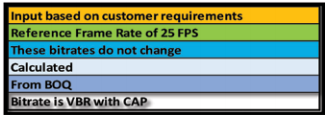 site survey is done to determine security vulnerabilities. This also helps us determine as to what other systems are required to complement the main CCTV system. Once the required information is gathered from the survey and documented, it becomes the driving force for subsequent phases of the project.
site survey is done to determine security vulnerabilities. This also helps us determine as to what other systems are required to complement the main CCTV system. Once the required information is gathered from the survey and documented, it becomes the driving force for subsequent phases of the project.
The best way to illustrate the process of building a security system is through an example. We are using an airport as the example. The following color coded table is used to distinguish the various inpurts/ requirements received from the customer.
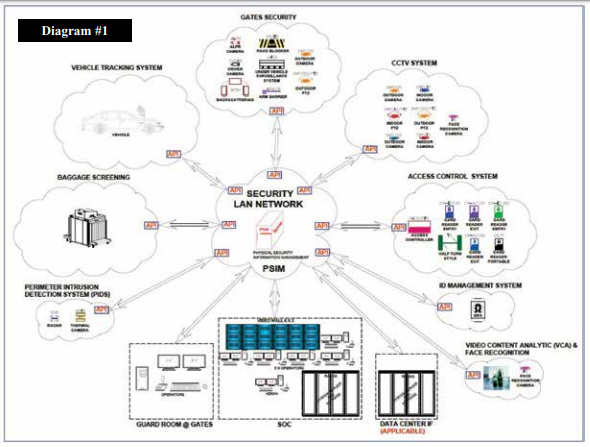
A typical airport is a super-set of any security deployment. We have used an airport as a used case. The illustrative airport diagram (#1) in the next page highlights all the components that constitute a surveillance/ security system. It also gives an idea of the other security components that need to be explored.
The following table is a standard template that can be used to capture security requirements. These inputs are used to design the entire security system which can then be used to calculate the cost of the implementation.
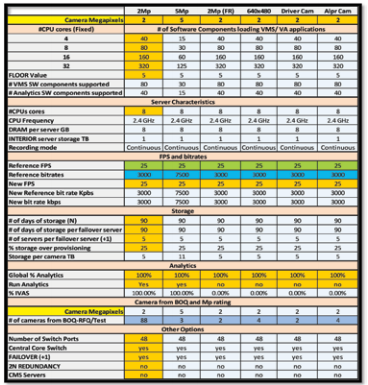
Using the above inputs from the customer and the respective bill of quantities (BoQs) for an airport, a complete design can be derived. The following table in the next page shows the output of the design process for 24 airports. Each airport has the same security requirements but BoQs are different.
Once the design is complete by 90% of the target specification the budgetary process starts involving various vendors, RFQs etc. As the process varies with regions, geographical locations must be taken into consideration.
Vendor selection
Vendor selection has a significant impact on the quality, robustness and overall cost of the system. Customers desirous of building a security system can engage subject matter experienced consultants who can guide and evaluate all the variables/ entities in the decision making process.
Cost optimization through simulation – The PGM way
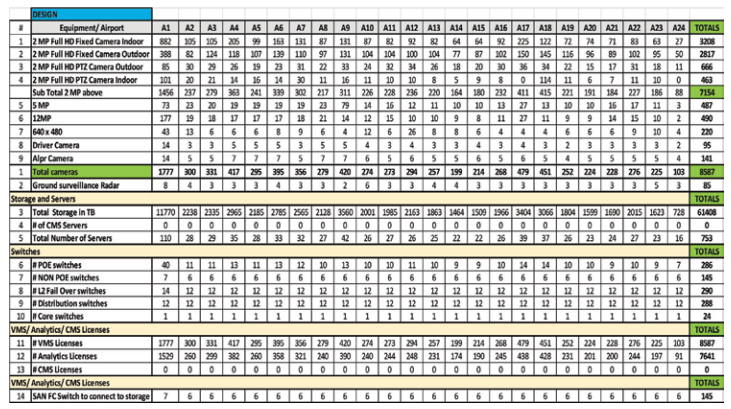
Design, build and implementation of a security solution are a complex system with many sub-systems within, that need to work in coordination with each other flawlessly. Every care must be taken in the early phases of the project as many variables are involved which can have a significant impact on the overall cost. One of the ways to enable this process is to run a simulation based on the customer inputs. Through a long and exhaustive experience we at the ‘PGM Security Group INTL’ have brought out the following facts:
- The customer knows what he wants but does not know how to get there.
- Almost all vendors oversell their products and services which do not benefit the customer in any way.
- A consultant is required in all cases to systematically evaluate all the options available and guide the customer to provide them with the highest performance at the lowest cost.
The following graphs show how PGM simulator determines the highest performance at the lowest cost. The X-Axis shows the percentage of cameras running video analytics (VA), and the Y-Axis the cost in a standardized format. The delta between the lowest and the highest costs is 3x. VA stands for video analytics and VMS stands for video management software. The green line is the overall cost with the other colored lines that sum up the overall green line cost.

Impact of Cost of Running Video Analytics for 24 airports
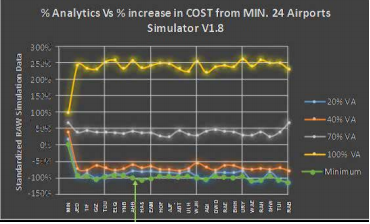
- Percentage of cameras running video analytics is the only single factor that influences overall CCTV system designed and hence overall cost.
- Can apply same design template across all airports as far as video analytics is concerned.
- Each airport has unique characteristics because of different BoQ camera quantities and functionality grouping of cameras.
- If one uses a single design template per airport then we run the risk of under served or over served airports unless a thorough analysis is done.
- As shown a 20% VA applied to all airports is more than sufficient to cover the difference in cost.
- All cameras running video analytics has a significant cost impact aross the board on the entire system.
- Individually setting every camera to run video analytics, their calibration to perform correctly becomes a management overhead.
- There is a significant increase in false alarms.

Cost increases exponentially as % VA increases from simulation
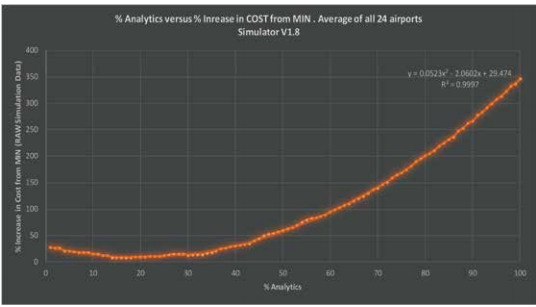
Summary
- A surveillance/ security system is a complex system comprising of several complex sub-systems.
- A complex system can and must be broken down into its sub-systems.
- An early iterative process is key to the longevity and success of the project.
- An elaborate planning phase at the start of the project is crucial because many surprises will spring up if due diligence is not done in the planning phase. Poor planning can and will lead to budgetary disasters. Being penny wise and pound foolish is typical in the surveillance and security industry. We caution against this approach.
The PGM Security INTL GROUP provides consulting services through all phases of the project. They have built a proprietary ‘Design Engine’ as well as a proprietary ‘Simulation Engine’ through years of experience dealing with customers and their security requirements. PGM Security always keeps the customer ‘first.’ We are reachable at pgm45868@gmail.com.
